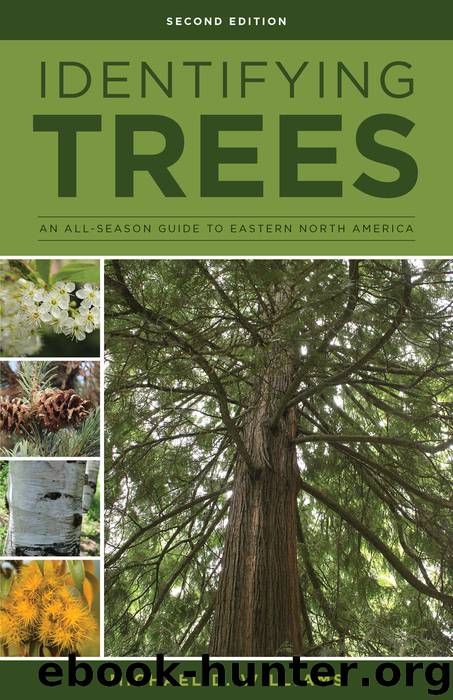Identifying Trees of the East by Michael D. Williams

Author:Michael D. Williams
Language: eng
Format: epub
ISBN: 9780811765633
Publisher: Stackpole Books
Pecan, Carya illinoinensis
Sweet Pecan
Mature Pecan trees growing in forested situations develop into very large, straight-stemmed trees with heights exceeding 170 feet (51.8 m) and occasionally reaching over 5⁵⁄₆ feet (1.8 m) in diameter at breast height. Cultivated varieties usually fork 4 to 8 feet (1.2 to 2.4 m) above the ground and are shorter with broad-spreading crowns. The bark on young trees is light brown to silver-gray, thin, split into short, narrow, flaky plates divided by intersecting shallow, narrow fissures. As the tree ages, the bark becomes rougher, forming long, narrow, thick, loosely attached plates divided by deep, narrow cracks. Many old trees have smoother patches of bark on the trunk, with unusual sets of straight indentations across the surface. These indented lines often intersect one another at angles, forming triangular shapes. They are so straight they look man-made. The strong limbs are well spaced and tend to come off the trunk at right angles.
Leaves (page 97) are 12 to 20 inches (304.8 to 508 mm) long, with eleven to seventeen short-stalked, curved, sharply pointed leaflets that are 3 to 7 inches (76.2 to 177.8 mm) long. The alternate, dark yellow-green leaves cluster at branch ends. Fine teeth rim the edges of leaflets.
Nuts are oval, husk-covered, and borne in clusters. The thin husk covering the nut has four tall wings running from base to tip.
Features: Pioneers found the Pecan throughout the South and harvested the prized nuts for food whenever they could beat wildlife to them. There are now many cultivars bred for better-tasting, larger nuts for home and commercial use. The wood is marketed as pecan or hickory and is used for furniture, flooring, and fuel. Pecans develop both male and female flowers on the same tree. Different varieties that match one tree’s male flowering dates to another tree’s female flowering dates are planted together to make sure pollination takes place and nuts are produced.
Natural Range: Pecan prefers growing in rich, moist river bottoms, and its major natural range is the lower Mississippi River valley. Within this region, the range reaches from southern Illinois to east Texas. Commercially developed cultivars are grown throughout the South.
Download
This site does not store any files on its server. We only index and link to content provided by other sites. Please contact the content providers to delete copyright contents if any and email us, we'll remove relevant links or contents immediately.
The Lonely City by Olivia Laing(4768)
Animal Frequency by Melissa Alvarez(4428)
All Creatures Great and Small by James Herriot(4271)
Walking by Henry David Thoreau(3923)
Exit West by Mohsin Hamid(3795)
Origin Story: A Big History of Everything by David Christian(3666)
COSMOS by Carl Sagan(3589)
How to Read Water: Clues and Patterns from Puddles to the Sea (Natural Navigation) by Tristan Gooley(3433)
Hedgerow by John Wright(3317)
How to Read Nature by Tristan Gooley(3292)
The Inner Life of Animals by Peter Wohlleben(3285)
How to Do Nothing by Jenny Odell(3264)
Project Animal Farm: An Accidental Journey into the Secret World of Farming and the Truth About Our Food by Sonia Faruqi(3189)
Origin Story by David Christian(3170)
Water by Ian Miller(3155)
A Forest Journey by John Perlin(3043)
The Plant Messiah by Carlos Magdalena(2900)
A Wilder Time by William E. Glassley(2835)
Forests: A Very Short Introduction by Jaboury Ghazoul(2815)
